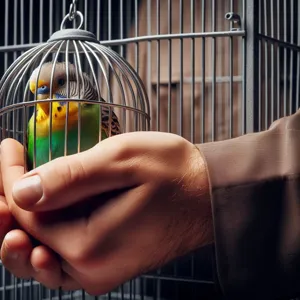For dog lovers, there’s nothing quite like watching our furry companions frolic and play in the great outdoors.
Dog parks are not just a place for pets to run free; they are vibrant social hubs where tails wag, friendships blossom, and hearts are filled with joy. If you’re a proud dog owner looking to unleash some fun, this guide will help you discover the best dog parks in your area, each offering unique features and amenities tailored to keep both you and your pup entertained. From sprawling green fields perfect for a game of fetch to agility courses that challenge your dog’s skills, these parks are designed to provide a safe and stimulating environment for your canine friend. Join us as we explore the top dog parks near you, complete with tips on what to expect, essential rules to follow, and how to make the most of your visit. Get ready to create unforgettable memories and build lasting connections in these canine playgrounds!
1. Introduction: The Importance of Dog Parks for Pets and Owners

Dog parks are more than just open spaces; they are vibrant havens where tails wag, paws scamper, and bonds between pets and their owners strengthen. For many dogs, these parks represent a paradise filled with opportunities to socialize, explore, and unleash their playful spirits. The importance of these communal spaces cannot be overstated, as they play a vital role in promoting physical and mental well-being for our furry companions.
For pets, dog parks offer a unique environment where they can interact with fellow canines, improving their social skills and helping to reduce anxiety or aggression. The chance to romp freely off-leash in a safe, enclosed area allows dogs to burn off excess energy, which is crucial for maintaining a healthy weight and preventing boredom-related behaviors at home. Furthermore, the diverse sights, sounds, and smells of a dog park stimulate their senses, providing mental enrichment that keeps them happy and engaged.
For dog owners, these parks serve as a community hub, fostering connections with fellow dog lovers. Whether it’s sharing training tips, exchanging stories about their beloved pets, or simply enjoying the camaraderie that comes with being part of a community, dog parks create a supportive environment for owners as well. They also provide an excellent opportunity for physical activity, as owners can participate in playtime, fetch games, or leisurely walks, all while enjoying the great outdoors.
In essence, dog parks are essential for nurturing the well-being of our pets and enhancing the lives of their owners. They provide a welcoming space where the joys of dog ownership are magnified, making them a must-visit destination for anyone looking to unleash some fun. So, grab your leash and discover the best dog parks near you—adventure awaits!
2. What to Look for in a Great Dog Park
When it comes to finding the perfect dog park for your furry friend, not all parks are created equal. A great dog park should be more than just a patch of grass; it should be a safe and engaging environment that caters to the needs of both dogs and their owners. Here are some key features to look for when scouting out the best dog parks near you:
**Safety First**: A well-maintained dog park should have secure fencing to prevent any escape artists from making a dash for freedom. Check for gates that are easy to operate but secure enough to keep your pup inside. Also, look for clear signage regarding park rules and regulations to ensure a safe experience for everyone.
**Space to Play**: Dogs need room to run and explore! Look for parks that offer ample space for your dog to unleash their energy. Ideally, there should be separate areas for large and small dogs, allowing for safe play and socialization without the worry of size differences leading to accidents.
**Amenities for All**: A great dog park should cater to both dogs and their humans. Look for amenities such as shaded benches, picnic tables, and water stations for hydration. Some parks even offer agility equipment for dogs to navigate, providing both exercise and mental stimulation.
**Cleanliness is Key**: A clean park makes for a pleasant experience. Check if the park has waste disposal stations with bags readily available for pet owners to clean up after their pups. Regular maintenance, such as trash collection and ground upkeep, is a sign of a well-managed park.
**Community Vibe**: One of the joys of visiting a dog park is the chance to meet other dog owners and their pets. Look for parks that foster a friendly community atmosphere, where owners can engage in conversation while their dogs romp and play together. A social environment can enrich your dog’s experience and provide opportunities for playdates.
By keeping these factors in mind, you’ll be well-equipped to find a dog park that not only meets your expectations but also provides a fun and safe space for your beloved pet to frolic and socialize. After all, a happy dog leads to a happy owner!
3. Benefits of Regular Visits to Dog Parks

Visiting dog parks regularly offers a myriad of benefits, not just for your furry friend but for you as well. First and foremost, these parks provide a safe and secure environment where dogs can roam freely, socialize, and engage in natural behaviors that are often curtailed in a typical home setting. The chance to run off-leash allows dogs to burn off excess energy, which is essential for maintaining a healthy weight and overall physical fitness. The exhilarating sprinting and playful wrestling with other dogs can significantly reduce the likelihood of destructive behaviors at home, such as chewing furniture or excessive barking.
Beyond physical health, dog parks are a goldmine for socialization. For dogs, interactions with their peers help them develop important social skills and reduce anxiety in unfamiliar situations. They learn to read canine body language, which can prevent aggressive behaviors down the line. For shy or anxious dogs, regular visits to the park can gradually build their confidence as they become accustomed to being around other dogs and people.
But it’s not just the dogs that benefit—owners can enjoy a wealth of advantages too! Dog parks serve as vibrant community hubs where you can meet fellow dog lovers, exchange tips, and forge new friendships. Whether you’re a new pet parent or a seasoned pro, sharing experiences and advice with others can enhance your dog-owning journey. Additionally, the relaxed atmosphere of a dog park provides a wonderful opportunity for owners to unwind, enjoy fresh air, and take a break from the hustle and bustle of daily life.
Moreover, many dog parks feature amenities such as agility courses, benches, and shaded areas, making them not only a fun outing for your dog but also a pleasant retreat for you. Regular visits to a local dog park can strengthen the bond between you and your pet, as you both engage in playful activities together while enjoying the camaraderie of the community. So grab your leash, pack some water, and head to your nearest dog park—it’s a win-win for you and your four-legged companion!
4. Top Features of the Best Dog Parks
When it comes to choosing the perfect dog park, certain features can elevate an ordinary outing into an extraordinary adventure for both you and your furry friend. Here are some top features to look for in the best dog parks:
**1. Safe and Secure Enclosures:** A great dog park should have well-maintained fencing that keeps your pup secure while allowing them to socialize and roam freely. Double-gated entries can help prevent any accidental escapes, giving you peace of mind as your dog plays.
**2. Separate Areas for Large and Small Dogs:** To ensure a safe play environment, the best parks often have designated areas for large and small breeds. This separation minimizes the risk of mishaps and allows dogs to engage with others of a similar size and energy level, making for more enjoyable play sessions.
**3. Ample Space to Roam:** Look for parks that offer plenty of space for your dog to stretch their legs. Open fields, shaded areas, and even natural obstacles like logs or hills can provide engaging environments for dogs to explore, run, and play.
**4. Water Stations:** Hydration is essential, especially on warm days. Top-notch dog parks will have water stations with bowls to keep your furry friend refreshed during their playful escapades.
**5. Waste Stations:** Responsible pet ownership includes cleaning up after your dog. The best parks are equipped with waste stations that provide bags and trash receptacles, ensuring the area remains clean and welcoming for everyone.
**6. Benches and Seating Areas:** While your dog is busy making new friends, you’ll appreciate comfortable seating where you can relax and enjoy the sights and sounds of the park. Benches, shaded areas, and picnic tables encourage socialization among dog owners, creating a sense of community.
**7. Dog-Friendly Amenities:** Some parks go the extra mile by including agility equipment, obstacle courses, or splash pads for dogs to enjoy. These features can turn a simple trip to the park into a fun and stimulating experience for your pet.
By looking for these essential features, you can ensure that your visits to the dog park are not only enjoyable but also safe and engaging for your four-legged companion. Happy exploring!
5. How to Find Dog Parks in Your Area

Finding the perfect dog park in your area can feel like a treasure hunt, but with a few strategic approaches, you’ll be on your way to uncovering some fantastic spots where your furry friend can romp and play. Start by tapping into the power of technology; a quick search on popular apps and websites such as ParkFinder, BringFido, or even Google Maps can yield a comprehensive list of dog parks nearby. These platforms often offer user reviews, photos, and essential details about the park’s amenities, such as water stations, agility courses, and separate areas for large and small dogs.
Local social media groups and community forums can also be gold mines for recommendations. Pet owners love to share their experiences, so don’t hesitate to ask fellow dog lovers in your neighborhood about their favorite parks. Additionally, consider checking with your local animal shelters or veterinary clinics; they often have up-to-date information on the best places to let your pup socialize and exercise.
Don’t overlook the importance of word-of-mouth! Engaging with other dog owners during walks or at pet stores can lead to exciting discoveries. While exploring, keep an eye out for parks that may not be officially designated as dog parks but are still pet-friendly. Many public parks allow dogs on leashes and can provide a wonderful space for you and your pooch to enjoy some fresh air and fun.
Lastly, remember that great dog parks often host events, meetups, and training sessions. By getting involved in these community activities, you can not only find a wonderful place for your dog to play but also meet other pet owners who share your passion for canine companionship. Happy hunting!
6. Safety Tips for Visiting Dog Parks
When visiting dog parks, ensuring the safety of your furry friend should always be a top priority. While these parks are designed to be fun and liberating spaces for dogs to socialize and play, they can also present certain risks. Here are some essential safety tips to keep in mind as you embark on your dog park adventures.
First and foremost, always supervise your dog during their playtime. Even the most well-behaved pups can get a little too excited or overwhelmed in an environment filled with other dogs. Keeping a close eye on your dog allows you to intervene if necessary, preventing any potential squabbles or incidents.
Before entering the park, make sure your dog is up to date on vaccinations and flea and tick prevention. This not only protects your own pet but also helps safeguard others in the park from common canine illnesses. A healthy dog is a happy dog, and it’s crucial for maintaining a safe community atmosphere.
Next, familiarize yourself with the park’s rules and layout. Many dog parks have designated areas for small and large breeds, so it’s important to know where to take your dog based on their size and temperament. This minimizes the risk of aggressive interactions and ensures a more enjoyable experience for all.
Additionally, always carry waste bags with you. Cleaning up after your dog is not only a courtesy to other park-goers but also promotes a clean, healthy environment for everyone. A well-maintained park is more inviting and safer for all dogs and their owners.
Lastly, take the time to observe your dog’s behavior. If you notice signs of stress or discomfort, such as excessive barking, hiding, or attempts to escape, it may be time to take a break or leave the park. Every pup has a unique personality, and understanding their limits is key to ensuring a positive experience.
By following these safety tips, you can help create an enjoyable atmosphere for your dog while allowing them to unleash their energy and socialize with fellow canine companions. After all, the goal of visiting a dog park is not only to have fun but also to ensure a safe and happy experience for every four-legged friend.
7. Essential Dog Park Etiquette for Owners

When it comes to enjoying a day at the dog park, understanding and adhering to essential etiquette is crucial not only for the safety and happiness of your furry friend but also for the enjoyment of others in the community. After all, a well-mannered dog owner sets the tone for a positive experience!
First and foremost, always ensure your dog is up to date on vaccinations and flea treatments before visiting. This not only protects your pet but also safeguards the health of other dogs in the park. Leashing your dog until you reach the designated off-leash area is another important rule. While your pup may be eager to run free, it’s essential to respect the boundaries and rules of the park.
Moreover, be vigilant and watchful over your dog’s behavior. If they start to show signs of aggression or excessive excitement, it’s your responsibility to intervene promptly. This helps prevent any unwanted incidents that could spoil the fun for everyone involved. Remember, not all dogs are as friendly or tolerant as yours may be.
Cleaning up after your dog is another fundamental aspect of park etiquette. Always carry poop bags and dispose of waste properly—no one wants to step in a mess! Keeping the park clean ensures that it remains a pleasant environment for all visitors, furry and human alike.
Lastly, be courteous to other dog owners. If you see someone struggling with their dog or in need of assistance, offer a helping hand. Respect personal space, and if someone prefers to keep their dog leashed, honor that choice. Engaging in friendly conversation can also be a great way to connect with fellow dog lovers and share tips about the local area.
By adhering to these essential dog park etiquette guidelines, you not only create a safer and more enjoyable environment for your pet but also foster a sense of community among fellow dog owners. So grab that leash, pack some treats, and head out to the park, where fun and friendship await!
8. Spotlight on the Best Dog Parks in [Your City/Region]
### Spotlight on the Best Dog Parks in [Your City/Region]
When it comes to providing your furry friend with a space to run, play, and socialize, nothing beats the charm of a well-designed dog park. In [Your City/Region], we are fortunate to have a variety of dog parks that cater to every pup’s needs, from spacious open fields to agility courses. Here’s a closer look at some of the best spots where tails wag and friendships bloom.
**1. [Park Name]**
Nestled in the heart of [Neighborhood/Area], [Park Name] is a canine paradise. This expansive park features a large, fenced-in area where dogs can roam off-leash, chase after balls, and meet new friends. With shaded benches for humans and plenty of water stations, it’s the perfect spot for a weekend outing. The park also hosts regular events like dog yoga and breed meet-ups, making it a vibrant community hub for dog lovers.
**2. [Park Name]**
For those who enjoy a more scenic view, [Park Name] offers stunning trails lined with trees and wildflowers. This park not only provides an off-leash area but also has designated hiking paths where dogs on leash can explore. The tranquil ambiance makes it a favorite among pet owners who prefer a quieter environment. Don’t forget to bring your camera—this park is known for its breathtaking sunset views!
**3. [Park Name]**
If your dog has a penchant for playtime, [Park Name] is the place to be! This park boasts an impressive agility course complete with tunnels, jumps, and weave poles that challenge even the most active pups. The vibrant atmosphere is often filled with the sounds of barking and laughter as dogs and their owners engage in friendly competitions. On weekends, you can often find local trainers offering free classes, providing a fantastic opportunity to enhance your furry friend’s skills.
**4. [Park Name]**
For those who prefer a smaller, more intimate setting, [Park Name] might be the perfect fit. This quaint dog park features a cozy fenced area and is often less crowded, making it ideal for shy pups or those that need a little extra space to feel comfortable. With picnic tables set around the perimeter, it’s a lovely spot to relax while your dog enjoys some playtime with their new pals.
**5. [Park Name]**
Last but not least, [Park Name] is a hidden gem that offers both a dog park and a water feature perfect for those hot summer days. Dogs can splash around and cool off in the designated doggy swimming area, providing a refreshing escape from the heat. This park is also equipped with agility equipment and plenty of grassy areas for romping around, ensuring your pup has a blast.
No matter which park you choose, one thing is certain: these dog parks in [Your City/Region] are designed to unleash fun and foster connections—not just for your dogs, but for you as well. So leash up, head out, and let the adventures begin!
9. Unique Amenities to Look for in a Dog Park
When it comes to finding the perfect dog park, amenities can make all the difference between a standard outing and an extraordinary experience for both you and your furry companion. While most parks will provide the basics—a fenced area, some grass to romp around on, and perhaps a bench for you to relax—there are several unique amenities that can elevate your visit and keep your pup coming back for more.
First on the list is **agility equipment**. Many dog parks are now incorporating obstacle courses featuring tunnels, jumps, and weave poles. These setups not only challenge your dog physically but also mentally, providing a perfect opportunity for training and bonding. Watching your pup navigate the course can be a delightful spectacle, and it encourages healthy exercise and skill-building.
Another amenity that can enhance your experience is **water features**. Look for parks that offer dog-friendly splash pads or ponds. On a hot day, nothing beats the joy of your dog wading through cool water, splashing around, and staying hydrated at the same time. This also provides a great setting for socialization with other dogs who love to swim and play.
**Shade structures** are also worth considering, especially during those sweltering summer months. A park with ample shaded areas allows both you and your dog to enjoy the outdoors without overheating. Look for parks that have trees, canopies, or even misting systems to keep the environment pleasant and inviting.
For the socially-inclined pups, **dog meet-up areas** or designated “small dog” sections can provide a safe space for your pet to mingle with others of similar size and temperament. These areas can reduce the stress of playtime for both shy dogs and their owners, ensuring a more enjoyable atmosphere.
Additionally, consider parks with **dog wash stations**. After a fun day of play, there’s nothing more convenient than having a designated area to rinse off the dirt and debris before heading home. This convenience not only saves you time but also keeps your car clean and your dog smelling fresh.
Finally, **seating and picnic areas** can enhance your visit, allowing you to relax while your dog plays. Look for parks that offer picnic tables, grill facilities, or even snack kiosks. This creates a community atmosphere, making it easy to enjoy a meal or a snack while watching your pup have a blast.
By keeping these unique amenities in mind, you can find the perfect dog park that not only caters to your dog’s needs but also enhances your overall experience, making every trip a fun and memorable adventure!
10. Seasonal Dog Park Activities and Events
When it comes to keeping your furry friend engaged and socialized, seasonal dog park activities and events can be a game changer. Many dog parks host a variety of events throughout the year, tailored to celebrate different seasons and holidays. Imagine a lively spring day filled with a doggie Easter egg hunt, where pups scurry around in search of hidden treats and toys among the blossoming flowers. It’s a fantastic opportunity for both dogs and their owners to connect with one another while enjoying the beauty of nature.
As summer rolls in, look out for “Yappy Hours” or dog-friendly barbecues, where owners can mingle over refreshments while their pets frolic in the sun, chasing frisbees or splashing about in kiddie pools. Many parks also organize agility courses and training workshops that help enhance your dog’s skills, providing an enriching experience for both of you.
When autumn arrives, it’s time for costume contests that turn the park into a parade of adorable outfits, from superheroes to pumpkins. These events not only showcase your dog’s personality but also foster a sense of community among local pet owners.
In the winter, don’t let the cold deter you! Some parks host holiday-themed gatherings complete with decorations, treats, and even Santa Paws photo opportunities. A winter wonderland can be the perfect backdrop for a doggie playdate, complete with snowballs and snow-dogs.
Participating in these seasonal activities not only keeps your dog’s tail wagging but also strengthens the bond you share with your pet and the community around you. So, keep an eye on your local dog park’s calendar and unleash the fun this season!
11. How to Create a Dog Park Playdate
Creating a dog park playdate can be one of the most rewarding experiences for both you and your furry friend. It’s not just about letting your dog run free; it’s about fostering socialization, building friendships, and strengthening the bond between you and your pet. Here’s how to orchestrate the perfect dog park playdate that ensures tail wags and happy barks all around!
**1. Choose the Right Park:** Start by selecting a dog park that is spacious and well-fenced, with separate areas for small and large dogs. Look for parks that have amenities like benches, water stations, and shade trees, which make for a comfortable environment for both dogs and their humans. Research reviews online or ask fellow dog owners for recommendations to find a spot that is popular and well-maintained.
**2. Invite Friends (Furry and Human!):** Reach out to fellow dog owners in your network or through social media groups dedicated to pet lovers. Invite friends with dogs that have compatible energy levels and temperaments to ensure a harmonious playdate. Setting a date and time that works for everyone helps build excitement and anticipation for the event!
**3. Pack the Essentials:** Prepare for the playdate by packing a bag with all the essentials. Bring water for your dog, collapsible bowls, waste bags for clean-up, and a few toys to encourage play. If your dog has any dietary restrictions, pack some treats to share with their playmates. Don’t forget your own supplies—snacks, a blanket to sit on, and maybe a book or a camera to capture the fun!
**4. Set Ground Rules:** Before letting the dogs loose, establish some ground rules to ensure safety and enjoyment. Discuss how to handle any potential conflicts and remind everyone to keep an eye on their pets. Encourage positive interactions by focusing on play rather than roughhousing, and be ready to intervene if necessary.
**5. Let the Fun Begin:** Once everyone arrives, unleash the excitement! Allow the dogs to explore and sniff each other, giving them the space to engage naturally. Play a few games of fetch or tag, or simply let them enjoy the freedom of running together. As the dogs romp around, enjoy the camaraderie with fellow dog owners, sharing stories and tips about your beloved pets.
**6. Wrap Up with a Treat:** As the playdate comes to a close, consider treating your dog (and their friends!) to some delicious snacks. A visit to a nearby pet-friendly café or a small picnic with homemade dog treats can be a delightful way to end the day. Not only will your dog leave happy and tired, but you’ll also have created lasting memories and perhaps even new friendships.
Creating a dog park playdate is about more than just exercise; it’s an opportunity for socialization, bonding, and fun. With a little planning and enthusiasm, you can unleash joy for both your dog and their new friends—ensuring that the wagging tails will be back for more!
12. What to Bring for a Fun Day at the Dog Park
Heading to the dog park can be an exhilarating experience for both you and your furry friend, but preparation is key to ensuring a fun-filled day. Here’s a checklist of essentials to bring along for an enjoyable outing that keeps tails wagging and spirits high.
**1. Water and a Portable Bowl:** Hydration is crucial, especially on warm days. Bring a collapsible water bowl and a bottle of fresh water to keep your pup cool and refreshed. Many dog parks have water stations, but it’s always best to come prepared.
**2. Waste Bags:** Cleanliness is a must at any dog park. Carry plenty of waste bags to pick up after your pet. Not only is this courteous to other park-goers, but it also helps maintain a clean and safe environment for everyone.
**3. Toys:** Pack your dog’s favorite toys—whether it’s a squeaky ball, frisbee, or rope—so they can engage in fun games with you or other dogs. Toys can also help break the ice and encourage friendly play among pups.
**4. Treats:** Bring a small stash of treats to reward good behavior or to help with training. Treats can also be a great way to coax your dog back to you if they get a little too excited during playtime.
**5. Leash and Harness:** While most dog parks allow dogs to roam off-leash, it’s a good idea to have a leash and harness handy for when you first arrive or for any situations that may require you to secure your dog.
**6. Shade and Shelter:** If you’re planning to stay for a while, consider bringing a portable shade umbrella or a lightweight blanket to sit on. This can provide a comfortable spot for both you and your dog to relax in the shade.
**7. First Aid Kit:** Accidents can happen, so it’s wise to have a basic pet first aid kit. Include items like antiseptic wipes, bandages, and any necessary medications your dog might need.
**8. A Good Attitude and Patience:** Lastly, don’t forget to bring your sense of fun and patience! Every dog is different; some may be social butterflies, while others might take a little time to warm up. Embrace each moment, and enjoy the opportunity for bonding and play.
By packing these essentials, you’re setting the stage for a fantastic day at the dog park filled with wagging tails, joyful barks, and cherished memories. So grab your gear and head out—adventure awaits!
13. Dealing with Behavioral Issues at Dog Parks
When visiting dog parks, it’s not uncommon to encounter a few behavioral challenges, whether it’s your own pup’s antics or the exuberance of others. Understanding how to address these issues is essential for ensuring a positive experience for both you and your four-legged friend.
First and foremost, it’s crucial to recognize the signs of stress or discomfort in your dog. If they’re exhibiting signs such as excessive barking, growling, or trying to hide, it may be time to step back and reassess the situation. Always keep a watchful eye on your dog’s body language, as it can provide valuable insights into how they feel in a crowded, stimulating environment.
If your dog tends to be a bit overzealous when interacting with others, consider employing a few training techniques beforehand. Reinforcing positive behaviors through treats or praise can help create a more sociable pup. Practicing commands like “sit,” “stay,” and “leave it” can also prove beneficial in managing unruly behavior during playtime.
In the event of an altercation or scuffle, remain calm and avoid shouting, which can escalate the situation. Instead, use your voice to firmly call your dog away, encouraging them to return to you. If necessary, you can gently redirect their attention with a toy or treat. It’s also prudent to be aware of other dogs’ owners and their comfort levels; open communication can go a long way in maintaining a peaceful atmosphere.
Lastly, remember that not every dog park is suitable for every dog. If your pet consistently struggles with certain behaviors, it may be worth exploring quieter parks or alternative playdates with familiar canine companions. By being proactive and attentive, you can ensure that your visits to the dog park are not only fun but also a safe haven for dogs to socialize and enjoy the outdoors together.
14. Dog Parks vs. Other Socialization Options
When it comes to socializing your furry friend, dog parks often steal the spotlight, but they aren’t the only option on the table. While dog parks offer a unique, off-leash environment where dogs can frolic freely and interact with their canine peers, it’s essential to weigh these benefits against other socialization avenues that might better suit your dog’s personality and needs.
Dog parks are a veritable playground of excitement, where the air buzzes with the sounds of barking, laughter, and the unmistakable joy of dogs at play. These parks typically feature open spaces, agility equipment, and designated areas for small and large breeds, allowing for a variety of interactions and play styles. The thrill of running alongside other dogs can help improve your dog’s confidence, burn off excess energy, and foster essential social skills. However, this vibrant atmosphere can be overwhelming for some dogs, especially those that are shy, anxious, or reactive.
In contrast, other socialization options may provide a more controlled environment. Consider doggy daycare, where your pup can interact with a smaller group of dogs in a supervised setting. This allows for tailored socialization experiences, ensuring that your dog connects with compatible playmates. Training classes can also serve as an excellent alternative, providing structured interactions under the guidance of a professional, which is particularly beneficial for young puppies learning the ropes of canine etiquette.
Additionally, neighborhood walks, playdates with trusted friends, or even visiting pet-friendly cafes can offer valuable socialization opportunities without the sometimes chaotic energy of a dog park. Each of these options allows for bonding time between you and your dog while exposing them to different environments and new experiences.
Ultimately, the best choice depends on your dog’s temperament and socialization goals. While dog parks can be a fantastic outlet for many dogs, don’t overlook the array of other socialization options that might better suit your furry companion. By exploring a mix of environments, you can ensure your dog develops into a well-rounded social butterfly, ready to tackle any new encounter with enthusiasm and confidence!
15. Conclusion: Making the Most of Your Dog Park Experience
As we reach the end of our journey through the delightful world of dog parks, it’s essential to reflect on how to truly make the most of your visits. Dog parks are more than just open spaces for your furry friend to run; they are vibrant social hubs where dogs and their humans can connect, exercise, and enjoy the great outdoors. To maximize your experience, consider a few key tips.
Firstly, choose the right time to visit. Early mornings or late afternoons are often less crowded, allowing for a more relaxed atmosphere where your dog can comfortably explore and make new friends. Pay attention to the weather, too—sunny days can be perfect for play, but don’t forget about hydration and shade, especially on hot afternoons.
Secondly, be an active participant. Engage with your dog, encouraging them to socialize with other pups while monitoring their interactions. This not only ensures safety but also helps reinforce positive behaviors. Bring along some toys or treats to facilitate introductions and keep the playtime fun and lively.
Lastly, remember the importance of etiquette. Always clean up after your dog, respect the park rules, and be considerate of other dog owners. A friendly wave or a brief chat with fellow dog lovers can foster community spirit and enhance your visits.
In conclusion, dog parks are more than just a play area; they are a fantastic way to enrich your dog’s life and strengthen your bond. By being mindful and engaged, you can transform each outing into an adventure filled with joy, exercise, and the simple pleasure of being in the company of fellow dog enthusiasts. So grab your leash, pack some treats, and head to your local dog park—where fun and friendship await!
As we wrap up our exploration of the best dog parks near you, we hope you feel inspired to grab your furry friend and embark on an adventure to these delightful outdoor spaces. Each park offers a unique blend of amenities, scenery, and social opportunities that can enhance your dog’s playtime while fostering connections with other pet owners in your community. Remember, a happy dog means a happy owner, and these parks are gateways to endless fun, exercise, and bonding experiences for both of you. So, lace up your shoes, pack some water, and unleash the joy that awaits at your local dog park. Don’t forget to share your adventures with us and let us know which park became your favorite! Happy exploring!








